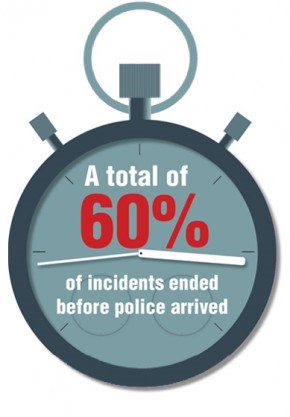ALICE – Active Shooter Response Training
ALERT – your first notification of danger
 ALERT is when you first become aware of a threat. The sooner you understand that you’re in danger, the sooner you can save yourself. A speedy response is critical. Seconds count.
ALERT is when you first become aware of a threat. The sooner you understand that you’re in danger, the sooner you can save yourself. A speedy response is critical. Seconds count.
Alert is overcoming denial, recognizing the signs of danger and receiving notifications about the danger from others. Alerts should be accepted, taken seriously, and should help you make survival decisions based on your circumstances.
LOCKDOWN – Barricade the room. Prepare to EVACUATE or COUNTER if needed
 If EVACUATION is not a safe option, barricade entry points into your room in an effort to create a semi-secure starting point.
If EVACUATION is not a safe option, barricade entry points into your room in an effort to create a semi-secure starting point.
Our training explains scenarios where LOCKDOWN may be the preferable option and dispels myths about passive, traditional ‘lockdown only’ procedures that create readily identifiable targets and makes a shooter’s mission easier. ALICE trainers instruct on practical techniques for how to better barricade a room, what to do with mobile and electronic devices, how and when to communicate with police, and how to use your time in lockdown to prepare to use other strategies (i.e. Counter or Evacuate) that might come into play should the active shooter gain entry.
INFORM – Communicate the violent intruder’s location and direction in real time
 The purpose of INFORM is to continue to communicate information in as real time as possible, if it is safe to do so. Armed intruder situations are unpredictable and evolve quickly, which means that ongoing, real time information is key to making effective survival decisions. Information should always be clear, direct and in plain language, not using codes. If the shooter is known to be in an isolated section of a building, occupants in other wards can safely evacuate while those in direct danger can perform enhanced lockdown and prepare to counter.
The purpose of INFORM is to continue to communicate information in as real time as possible, if it is safe to do so. Armed intruder situations are unpredictable and evolve quickly, which means that ongoing, real time information is key to making effective survival decisions. Information should always be clear, direct and in plain language, not using codes. If the shooter is known to be in an isolated section of a building, occupants in other wards can safely evacuate while those in direct danger can perform enhanced lockdown and prepare to counter.
Video surveillance, 911 calls and PA announcements are just a few of the channels that may be used by employees, safety officers, and other personnel to inform others. An emergency response plan should have clear methods outlined for informing school employees, hospital workers, or any other employees of the location of a violent intruder.
COUNTER – Create Noise, Movement, Distance and Distraction with the intent of reducing the shooter’s ability to shoot accurately. Counter is NOT fighting
 ALICE Training does not believe that actively confronting a violent intruder is the best method for ensuring the safety of those involved. Counter is a strategy of last resort. Counter focuses on actions that create noise, movement, distance and distraction with the intent of reducing the shooter’s ability to shoot accurately. Creating a dynamic environment decreases the shooter’s chance of hitting a target and can provide the precious seconds needed in order to evacuate.
ALICE Training does not believe that actively confronting a violent intruder is the best method for ensuring the safety of those involved. Counter is a strategy of last resort. Counter focuses on actions that create noise, movement, distance and distraction with the intent of reducing the shooter’s ability to shoot accurately. Creating a dynamic environment decreases the shooter’s chance of hitting a target and can provide the precious seconds needed in order to evacuate.
EVACUATE – When safe to do so, remove yourself from the danger zone
 ATI provides techniques for safer and more strategic evacuations. Evacuating to a safe area takes people out of harm’s way and hopefully prevents civilians from having to come into any contact with the shooter.
ATI provides techniques for safer and more strategic evacuations. Evacuating to a safe area takes people out of harm’s way and hopefully prevents civilians from having to come into any contact with the shooter.
Did you know that you should break a window from the top corner as opposed to the center? Many useful techniques that civilians do not know exist and can save your life. ALICE trainers teach strategies for evacuating through windows, from higher floors and under extreme duress.
Active Shooter, Noun ‘ak-tiv ‘shu-ter
The agreed-upon definition of an “active shooter” by US government agencies (including the White House, US Department of Justice, FBI, US Department of Education, US Department of Homeland Security, and Federal Emergency Management Agency) is “an individual actively engaged in killing or attempting to kill people in a confined and populated area.” In most cases, active shooters use firearms and there is no pattern or method to their selection of victims.
Active shooter situations are unpredictable and evolve quickly. Because active shooter situations are often over within 10 to 15 minutes, before law enforcement arrives on the scene, individuals must be prepared both mentally and physically to deal with an active shooter situation. In most cases, active shooters use firearms(s) and there is no pattern or method to their selection of victims. Individuals have been known to act without firearms such was the case in on April 2014 at Franklin Regional High School where 21 students were stabbed. It’s for this reason that ALICE also uses the terms: Active Killer; Violent Intruder; and Active Assailant.
- Active Killer
- Violent Intruder
- Active Assailant
Characteristics of an Active Shooter
A number of police and sheriffs department policies list characteristics that are often associated with active shooters. The policies note that each incident is unique and that no list of active shooter characteristics is comprehensive. The characteristics cited in various policies include:
- Active shooters are likely to engage more than one target. They may target particular individuals or they may be intent on killing as many randomly chosen people as possible. Active Shooters often go to location with high concentrations of people, such as schools, theaters, shopping center, or other places of business.
- Active shooters’ intentions is usually an expression of hatred or rage, rather than financial gain or motives associated with other types of crimes. Thus, police tactics of containment and negotiation may be an inadequate response to and active shooter.
- Active shooters often have made detailed plans for the attack. In many cases, they are better armed that the police. They usually have some familiarity with the chosen location.
- Active shooters often, but not always, are suicidal. Escape from the police is usually not a priority of an active shooter. Most active shooters have not attempted to hide their identity.
- In some situations, active shooters choose a location for a tactical advantage.
Police Response Time can never be Fast Enough: Establishing Partnerships between Police and Community
 ALICE Training Institute was established by a former police officer. Fifteen years later, ALICE Training continues to be the leading active shooter response program in the country due to the Police / LE community.
ALICE Training Institute was established by a former police officer. Fifteen years later, ALICE Training continues to be the leading active shooter response program in the country due to the Police / LE community.
Lockdown was the standard active shooter response method for many years, but almost every police officer in America has had a conversation similar to this with their children: “If you ever see someone with a gun other than mommy, daddy or a police officer, you need to run fast.”
Police officers know the volatile dangers of any aggressive intruder and active shooter event. These attacks can happen unexpectedly and produce devastating outcomes within a few short minutes making even the fastest law enforcement response-time futile.
According to the FBI’s 2014 report on active shooter situations, 69% of incidents lasted less than five minutes. Consequently, 60% of incidents ended before police arrived. Police officers understand the necessity of teaching proactive safety and response tactics to citizens.
ALICE Training K-12 Program
Raising the Bar in School Security
Each school day, our nation’s schools are entrusted to provide a safe and healthy learning environment for approximately 55 million elementary and secondary students in public and nonpublic schools. Families and communities expect schools to keep their children and safe from all threats including human-caused emergencies such as crimes of violence. In collaboration with local government and community stakeholders, schools can take steps to plan and prepare to mitigate these threats. Every school Emergency Operating Procedure (EOP) should include courses of action that will describe how students and staff can most effectively respond to an Active Shooter situation to minimize the loss of life, and teach and train on these practices. No single response fits all active shooter situations however, making sure each individual knows his or her options for response and can react decisively will save valuable time.
SCHOOL SECURITY: A DUTY TO PROTECT
Since Jefferson founded public education for the citizens of the United States, schools have been charged with the safety of children in their care – a duty to protect. Teachers and administrators have a responsibility to anticipate potential dangers and to take precautions to protect their students from those dangers.
DOES YOUR K-12 DISTRICT HAVE A SCHOOL SECURITY PLAN?
Find out if your K-12 School is prepared to respond to the threat of an active shooter. Take our FREE Active Shooter Vulnerability Self-Assessment.
ALICE Training: THE STANDARD OF CARE
If a school district fails its duty to protect students from injury and an appropriate standard of care was not used, the district can be found negligent. The standard of care is not a statute or regulation that can be pointed to and expounded upon. The standard of care is a concept that is argued in courtrooms requiring school districts to answer questions like:
- Did you comply with federal & state recommendations?
- Is your policy consistent with comparable schools?
- Did you comply with your own stated policy?

